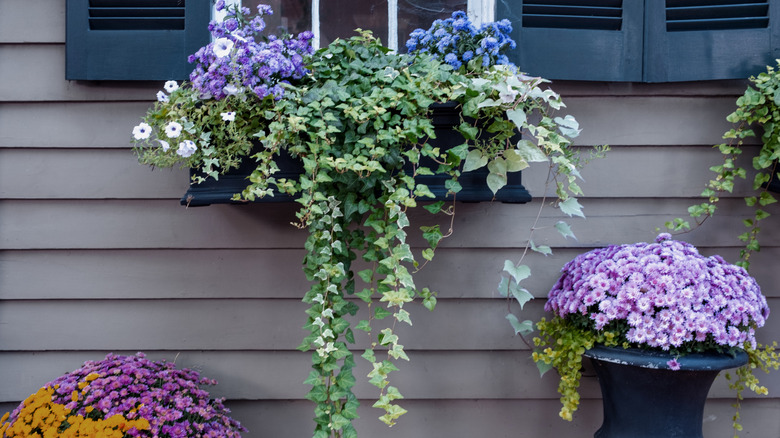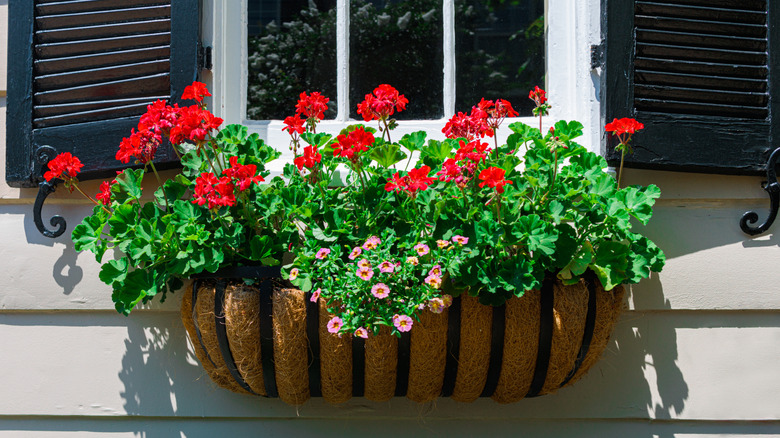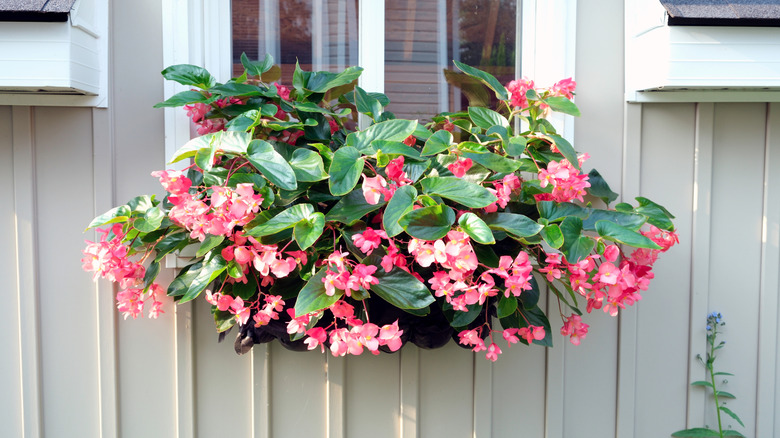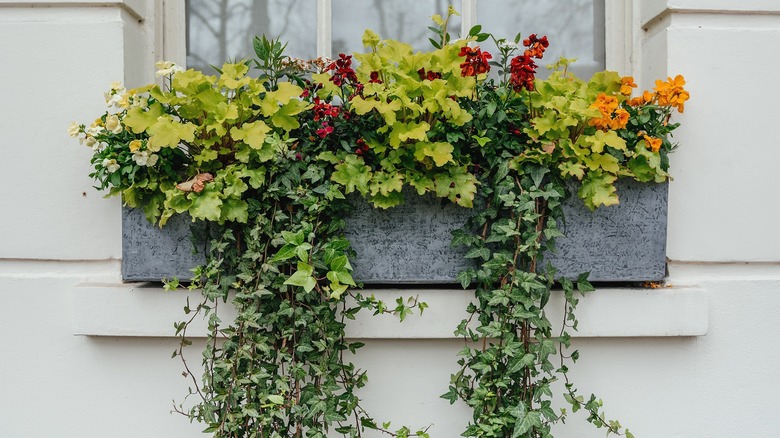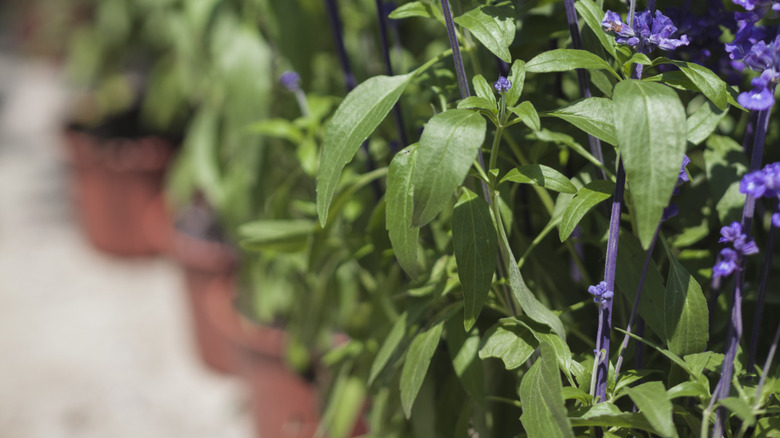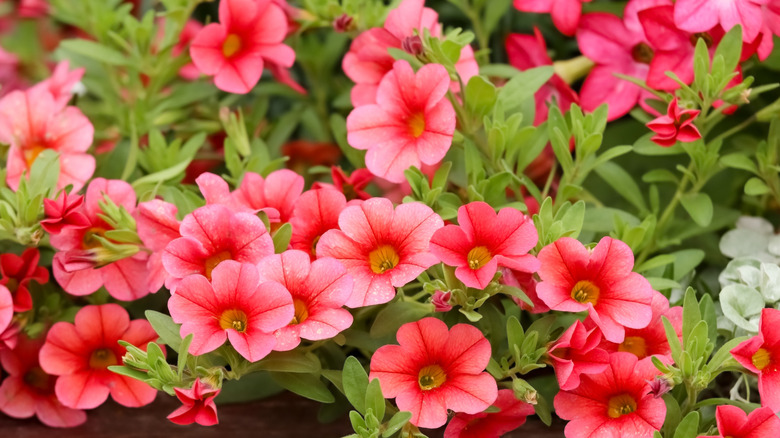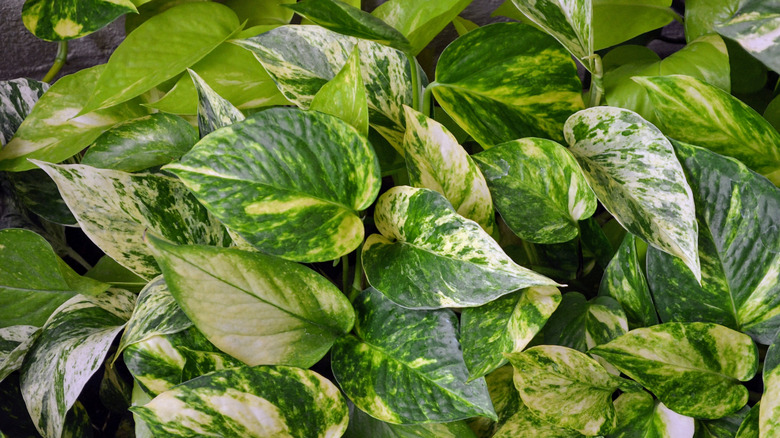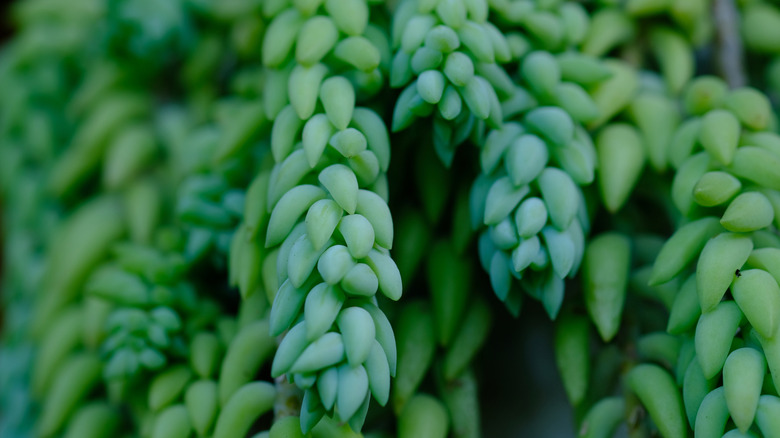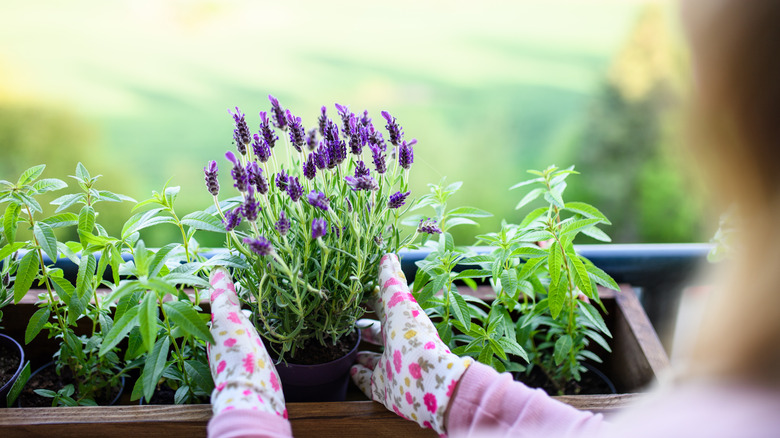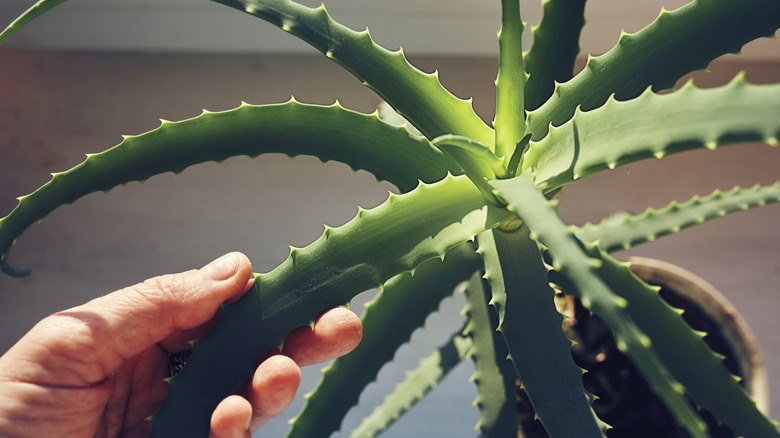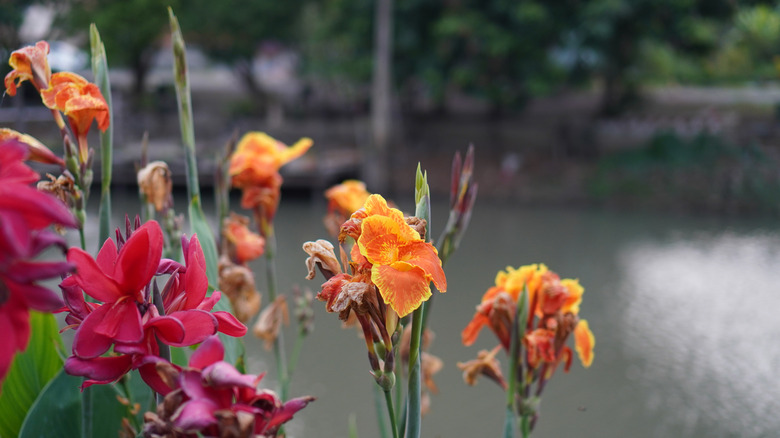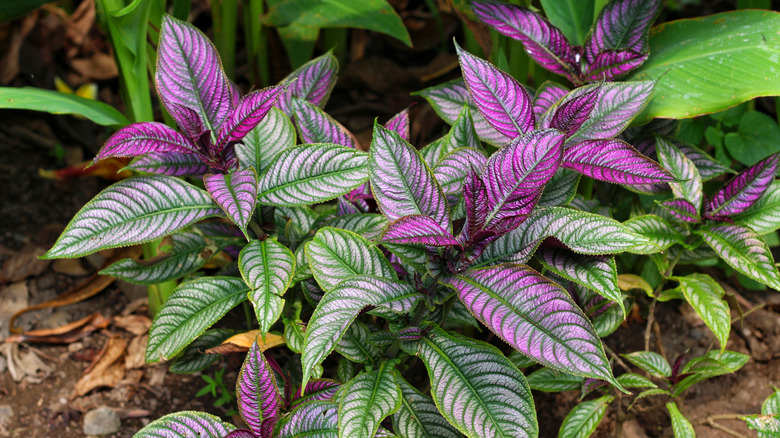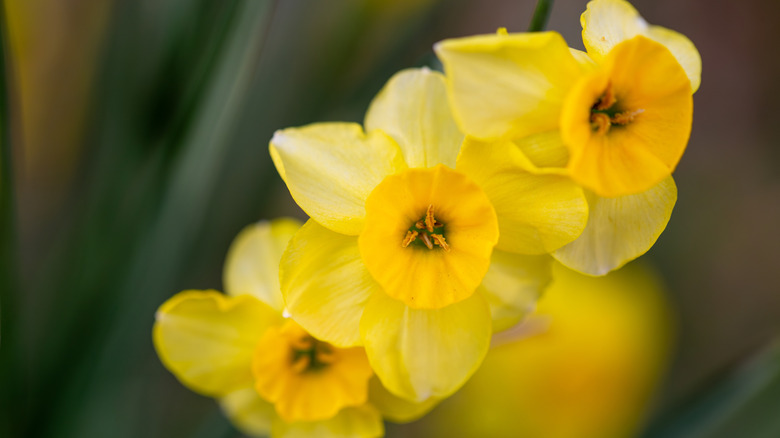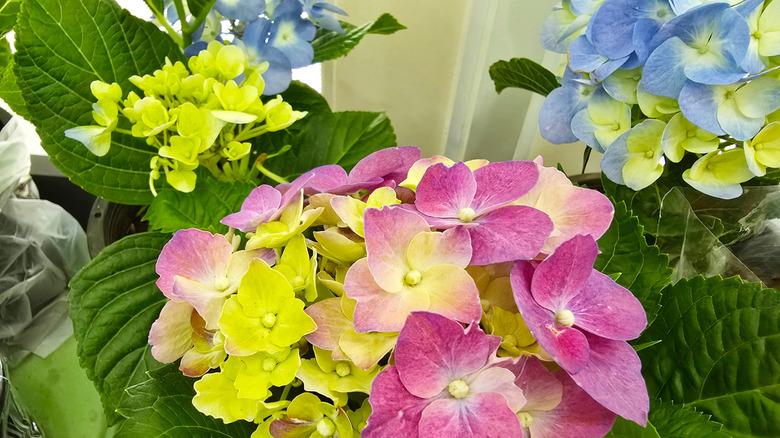The 13 Best Bold Plants For Eye-Catching Window Displays
A window box is a happy addition to any gardener's repertoire. Whether you have a large piece of property with beautiful garden borders, or you live in a townhouse with little to no garden, a window box can provide that extra bit of color and greenery to any home. These versatile containers can easily dress up a home's exterior, and are nearly limitless when it comes to decorative potential, as they can accommodate many different types of plants. If you are looking for attractive plants to add to your window box, here are some of the best bold additions you can choose.
If you're looking for a splash of color, you can plant cheerful flowers like geraniums or petunias in your window box. For a more cottage-type vibe, lavender and Boston ivy could be attractive options. Individuals residing in tropical locations can even install plants like aloe vera and canna lilies, which provide a fascinating array of textures and shapes. Always check a plant's USDA hardiness growing zone range to ensure it thrives in your location, or learn how to care for it during extreme heat or cold, depending on the plant. No matter the visual you are going for, selecting the best flowering plants for your window box or other bold plants can be a creative project that will revitalize the look of your home.
Geraniums
Geraniums offer a colorful pop for a window display and are sun-loving plants (zones 3 to 9) that will thrive with the proper care. Be sure to position them in a spot where they will get sufficient sun — at least 6 hours a day — they also need well-draining soil and like to have their root systems moist but never overly wet or dry. There are multiple colors to choose from as well, giving you lots of freedom to design the window box of your dreams.
Begonias
Known for their gorgeously bright blooms, begonias are a natural choice for a window box plant. They come in a variety of hues, including red, pink, orange, and purple, to name a few. Begonias thrive in sunny conditions and can also do well in shade, meaning they can roll with the changes in daylight that occur when in a stationary or partially obscured location, such as a window box. in zones 9 to 11, they often grow as perennials, whereas they'll usually be planted as annuals in zones 3 through 8, with some exceptions.
Ivy
Ivy might not initially strike you as a bold plant, but this green climbing vine can make a big impression if properly installed in your window display. Boston Ivy is well-loved for its hardiness, rapid growth, and robust appearance, making it a great option for a window display, especially if you let it hang down for dramatic appeal. You can easily get your ivy growing properly with a placement in a partial to full sunlight and moist, well-draining soil (zones 4 through 8).
Salvia
The pollinator-attracting blossoms of a salvia will quickly improve the appearance of any window display. From their dramatic purple flowers, to the bees and butterflies that flock to them, there will be no shortage of visual value with the installation of salvias. For the best blooms, you'll want to ensure your salvia has full sunlight and well-draining soil. Various varieties thrive in different zones, but generally from 8 through 11. You can select a dramatic hue of salvia, such as a red Scarlet Sage (Salvia splendens) to catch the eye of any window box admirer.
Calibrachoa
If your window box is a littler deficient when it comes to bright and cheerful colors, adding some calibrachoa into your planter could be a great choice. These plants are easy to care (zones 9 to 11) for and boast gorgeous blooms from spring through fall that will trail for extra visual appeal. They also come in a huge range of colors, so you can select the most attractive shade for your preferences.
Pothos
This beautiful and wild-looking type of ivy is an excellent addition to your window display. Able to grow in dark or light conditions, Pothos can also handle being forgotten for quite some time — only requiring water when the soil is completely dry — as well as being happy in a variety of soil qualities. If you live in a cooler climate, the Pothos will struggle when temps dip below 50 degrees, but otherwise they should be quite hardy (zones 10 through 12 for best results).
Burro's tail
For an enchanting vibe, check out the Burro's Tail, a succulent that has incredible dimension to bring to your window box. The Burro's Tail is highly interesting to look at but may not be suitable for every plant lover: As a succulent (zones 10 to 11), you'll need to ensure that it has dry enough conditions and sufficiently warm temperatures or else it won't stay healthy. It also wants lots of sunlight, but too much direct light can cause the color to become overly yellow and pale.
Lavender
Lavender can prove to be a good plant for window boxes provided you give it the correct growing conditions (zones 5 to 10). As a Mediterranean plant, lavender likes dry soil, not too much water, and lots of sunlight. Beyond looking wonderful, the lavender will bring a breathtaking scent to your home and attract pollinators like bees and butterflies to your window display.
Aloe vera
Although it might not seem a natural plant to place in your window box, its a fabulous choice if you can guarantee good growing conditions (zones 9 to 11). In addition to having wonderful texture, the size of an aloe plant can be impressive once it become mature — they can also produce spectacular blooms with time. Be careful to not overwater the soil and to make sure the composition allows for good drainage. Place your aloe in a window box with indirect sunlight for 6-8 hours each day for a shot at the healthiest plant.
Canna Lily
For a stunning window box flower that will be sure to turn heads, look no further than the Canna Lily. These tall flowers work well in containers and offer a unique degree of height that can give your window display the dimension you've been craving. You'll also find that their flowers come in bold, striking colors, such as a fiery orange or bright red. If you want to know
how to grow and take care of Canna Lilies,
they'll do best in hot, humid locations (zones 8 through 11), and can thrive in a variety of soils, making them a good choice for beginner gardeners.
Persian shield
A splash of purple can do wonders for your window display and the Persian shield — a Victorian-era foliage to grow in your garden for a pop of color — delivers a beautiful array of hues and textures to enjoy. You'll find that this plant does well in containers, which naturally limits its ultimate size. For best results, place in a high-quality soil with plenty of sunlight — though if you reside in a hot, southern location (zone 10 and higher), the Persian shield will thrive in partial sunlight. Water regularly to prevent the soil from drying out too much.
Daffodils
It is hard to think about springtime without a bright yellow daffodil coming into your mind's eye. Thanks to their cheerful appearance and perky positioning, daffodils make a wonderful addition for any window display. In order to have the best luck with your daffodils, you'll want to ensure that the bulbs are planted deep enough in the window box, as well as having soil that drains well. Be sure to give your daffodils full light for 6 to 8 hours every day. Daffodils thrive best in zones 3 through 8 or 9, with a cold winter.
Hydrangeas
Hydrangeas do well in containers and their bushy and bright bunches of blossoms make for a beautiful addition to your window display. You can score hydrangeas in a variety of colors, ranging from pink and white to purple and blue. With the right conditions (zones 3 through 9), hydrangeas will grow successfully. Avoid the mistakes everyone makes when growing hydrangeas in containers by ensuring they have well draining soil that stays moist, and partial to full sunlight.
